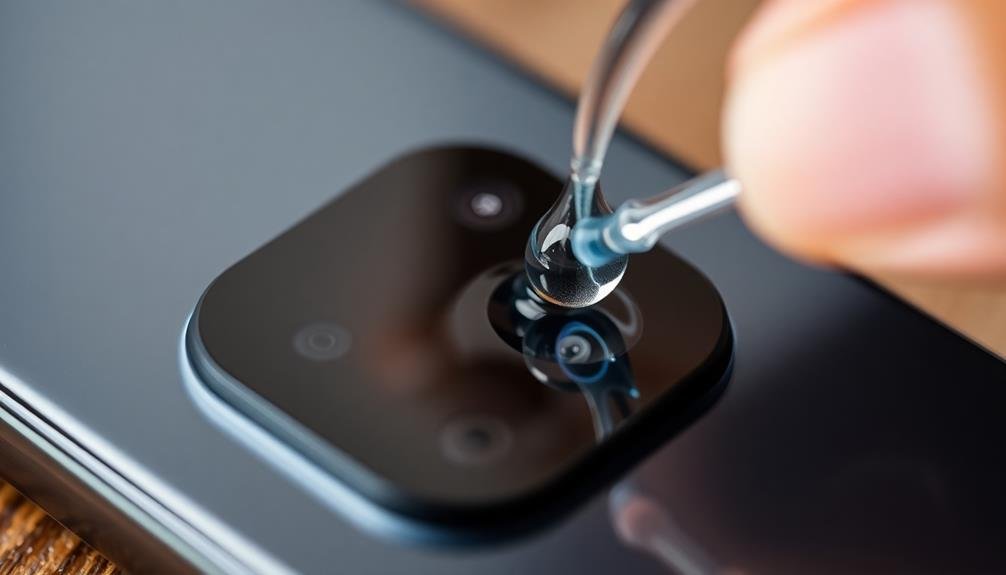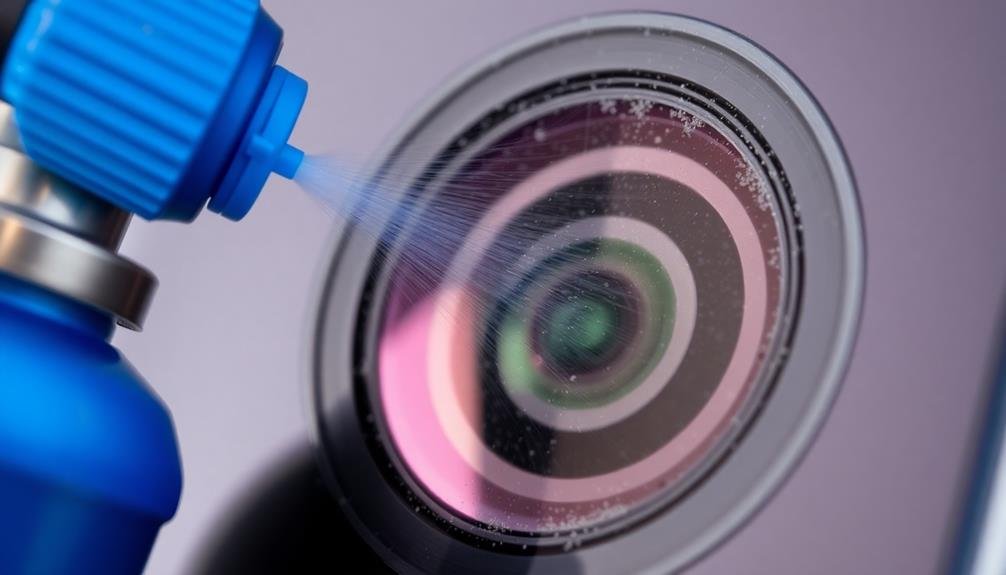To safely clean your smartphone camera, you've got three effective methods at your disposal. First, use a lint-free microfiber cloth, gently wiping in circular motions from the center outward. For stubborn smudges, lightly dampen the cloth with distilled water. Second, apply a specialized lens cleaning solution to a microfiber cloth, avoiding alcohol-based products. Third, employ compressed air, holding the can upright and using short bursts from a safe distance. Always start by removing loose particles and use gentle pressure. By mastering these techniques, you'll guarantee your phone captures crystal-clear images every time. Discover the nuances of each method to perfect your cleaning routine.
Microfiber Cloth Method

Simplicity is key when it comes to cleaning your smartphone camera. The microfiber cloth method is one of the easiest and most effective ways to keep your lens spotless. You'll need a clean, lint-free microfiber cloth designed for optical surfaces. These cloths are gentle enough to avoid scratching your camera lens while effectively removing fingerprints, dust, and smudges.
To begin, gently breathe on the lens to create a light mist. This helps loosen any stubborn particles. Next, use the microfiber cloth to wipe the lens in a circular motion, starting from the center and moving outward. Apply light pressure to avoid damaging the lens coating.
If you encounter persistent smudges, dampen a small corner of the cloth with distilled water and repeat the process.
Don't use household cleaners, solvents, or abrasive materials, as these can damage your camera's delicate components. Also, avoid using your shirt, tissues, or paper towels, which can leave lint or scratches.
After cleaning, store your microfiber cloth in a sealed plastic bag to prevent contamination. Regular cleaning with this method will help maintain your smartphone camera's image quality and longevity.
Lens Cleaning Solution Technique

For tougher grime, a lens cleaning solution can be more effective than a microfiber cloth alone.
You'll want to choose a solution specifically designed for camera lenses, as these are gentle enough for your smartphone's delicate optics. Avoid using household cleaners or alcohol-based products, which can damage the lens coating.
To use the solution, first, blow off any loose particles. Then, apply a small amount of the cleaner to a microfiber cloth—never directly to the lens. Gently wipe the lens in a circular motion, starting from the center and moving outward.
Be careful not to apply too much pressure, as this could scratch the lens. After cleaning, use a dry part of the cloth to remove any remaining moisture. It's essential to verify the lens is completely dry before using your phone again.
If you're dealing with stubborn marks, you may need to repeat the process, but always use a clean part of the cloth for each attempt.
Remember to clean your phone's camera lens regularly to maintain image quality and prevent buildup of dirt and oils.
Compressed Air Approach

Caution is key when using compressed air to clean your smartphone camera lens. While it's an effective method for removing loose debris, improper use can damage your device.
Always hold the compressed air can upright and at least 6 inches away from the lens. Short, quick bursts are more effective than prolonged spraying, which can introduce moisture or propellant residue onto the lens.
Before using compressed air, gently tap your phone's edges to dislodge any large particles. This prevents them from being forcefully pushed into crevices during air cleaning.
Focus the air stream on the lens and its surrounding areas, but avoid spraying directly into speaker grilles or other openings.
If you're cleaning multiple devices, use a new can of compressed air to prevent cross-contamination.
After air cleaning, inspect the lens closely for any remaining smudges or particles. For stubborn spots, follow up with a microfiber cloth or lens cleaning solution.
Frequently Asked Questions
How Often Should I Clean My Smartphone Camera?
You should clean your smartphone camera regularly, ideally once a week. If you use it frequently or in dusty environments, clean it more often. Don't forget to gently wipe the lens before important photo opportunities.
Can I Use Regular Eyeglass Cleaner on My Phone Camera?
You shouldn't use regular eyeglass cleaner on your phone camera. It may contain harsh chemicals that can damage the lens coating. Instead, use a microfiber cloth slightly dampened with distilled water or a specialized smartphone cleaning solution.
Is It Safe to Clean My Smartphone Camera While the Device Is On?
It's generally safe to clean your smartphone camera while it's on, but it's better to turn it off first. You'll avoid accidental button presses and reduce the risk of moisture damage to internal components.
What Should I Do if Water Gets Into the Camera Lens?
If water gets into your camera lens, act quickly. Turn off your phone immediately and remove the battery if possible. Don't turn it on. Use silica gel packets or uncooked rice to absorb moisture. Seek professional help if issues persist.
Can Extreme Temperatures Affect the Cleaning Process of Smartphone Cameras?
Yes, extreme temperatures can affect your camera cleaning process. Heat can cause cleaning solutions to evaporate quickly, while cold may thicken them. You'll want to clean your smartphone camera in moderate temperatures for best results.
In Summary
You've now got three reliable methods to keep your smartphone camera sparkling clean. Whether you opt for the gentle microfiber cloth, the thorough lens cleaning solution, or the quick compressed air approach, you'll guarantee your photos stay crisp and clear. Remember, regular cleaning prevents buildup and maintains image quality. Don't forget to be gentle and avoid excess moisture. With these techniques, you're all set to capture life's moments in perfect clarity.





Leave a Reply